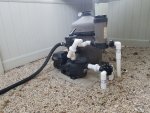As this pool season comes to close in NY, I am starting to plan my spring heat pump installation. Right now I am at the baby phase of learning about heat pumps.
First question....all the plumbing for my pool, pump, filter etc. is 1.5". All the heat pumps I am looking at in the 125k btu range are 2".
Does this restriction pose a problem for the heat pump or is a reducer the simple answer with perhaps the only issue being less gpm?
First question....all the plumbing for my pool, pump, filter etc. is 1.5". All the heat pumps I am looking at in the 125k btu range are 2".
Does this restriction pose a problem for the heat pump or is a reducer the simple answer with perhaps the only issue being less gpm?



